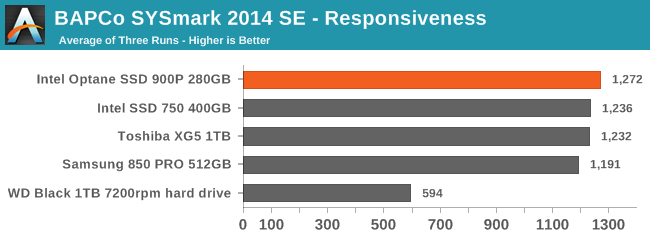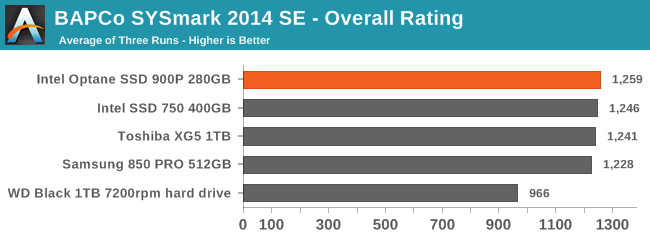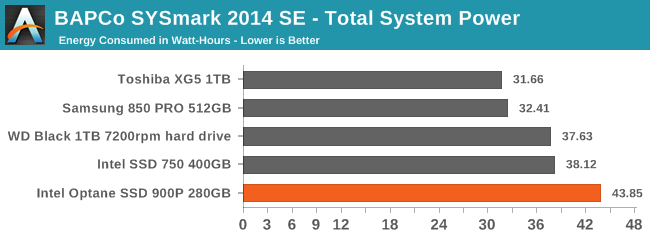The Intel Optane SSD 900P 280GB Review
by Billy Tallis on October 27, 2017 9:30 AM ESTBAPCo SYSmark 2014 SE
BAPCo's SYSmark 2014 SE is an application-based benchmark that uses real-world applications to replay usage patterns of business users in the areas of office productivity, media creation and data/financial analysis. In addition, it also addresses the responsiveness aspect which deals with user experience as related to application and file launches, multi-tasking etc. Scores are calibrated against a reference system that is defined to score 1000 in each of the scenarios. A score of, say, 2000, would imply that the system under test is twice as fast as the reference system.
SYSmark scores are based on total application response time as seen by the user, including not only storage latency but time spent by the processor. This means there's a limit to how much a storage improvement could possibly increase scores, because the SSD is only in use for a small fraction of the total test duration. This is a significant difference from our ATSB tests where only the storage portion of the workload is replicated and disk idle times are cut short to a maximum of 25ms.
| AnandTech SYSmark SSD Testbed | |
| CPU | Intel Core i5-7400 |
| Motherboard | ASUS B250-PLUS |
| Chipset | Intel B250 |
| Memory | 2x 8GB Kingston DDR4-2400 CL17 |
| Case | In Win C583 |
| Power Supply | Cooler Master G550M |
| OS | Windows 10 64-bit, version 1703 |
Our SSD testing with SYSmark uses a different test system than the rest of our SSD tests. This machine is set up to measure total system power consumption rather than just the drive's power.


SYSmark 2014 SE doesn't come close to stressing the storage system enough to show meaningful distinctions between high-end NVMe SSDs. The Responsiveness sub-test is the most sensitive to storage performance, and only shows a few percent difference between most SSDs. The overall test barely registers a difference at all. But with my primary power meter broken, SYSmark does provide a rough assessment of how power hungry the Intel Optane SSD 900P is:

The SYSmark energy usage scores measure total system power consumption, excluding the display. Our SYSmark test system idles at around 26 W and peaks at over 60 W measured at the wall during the benchmark run. SATA SSDs seldom exceed 5 W and idle at a fraction of a watt, and the SSDs spend most of the test idle.
Despite being the fastest drive in this bunch and thus the one with the shortest SYSmark run times, the Optane SSD 900P used far more energy over the course of the three SYSmark runs. With higher idle power than even the Intel SSD 750 and similar power draw under load, the Optane SSD 900P really needs its heatsink. Intel is a very long way off from being able to package this level of performance in a M.2 SSD.










205 Comments
View All Comments
ddriver - Friday, October 27, 2017 - link
You probably missed the slide where intel positions this product at "eSports" - believe it or not, it will make a world of a difference. You may not see even 1% of improvement, but it will definitely make you much better at eSports.But then again, you can get exactly the same benefit from just putting a sticker on your box, without actually paying for the product. It is enough for others to think you have it.
Sarcasm aside, at this price it is a good purchase for database usage. But only if very low latency is required, meaning a local server on a very fast network, and the server is being lightly loaded. For an internet server the advantages will be diminished by the internet connection bottleneck, and for higher loads, as evident from the test results, SSDs do catch up as the QD increases, and still offer significantly lower cost per GB.
lmcd - Friday, October 27, 2017 - link
While the endurance shut-off seems pretty ridiculous, I'd imagine as this technology ramps up its density and cost-efficiency it will supplant traditional NAND in the data center before traditional NAND even garners much of a foothold.iwod - Saturday, October 28, 2017 - link
I think the reality is 90% of consumers are never going to hit that endurance number, ever. Statiscally speaking, they are much more likely to get a Memory Error, Capacitor malfunction, Power Supply issues or likely their CPU heat cooling system ( Increasingly a problem ) messed up before that number ever arrived.And I think another problem, is Intel cant figure out the best endurance time and method on this new tech. And they are playing it safe then sorry. Running a 10 PB test takes time.
"Bullwinkle J Moose" - Friday, October 27, 2017 - link
Thank you ddriverI was going to let the My Banhammer stand until I remembered why I love this site so much...
It's not the articles, it's the comments
You have learned well my friend!
eddman - Sunday, October 29, 2017 - link
Horses attached to the same carriage. Keep pulling.peevee - Friday, October 27, 2017 - link
Looks like this thing is fast enough to be used as swap drive for memory-intensive tasks.Reflex - Friday, October 27, 2017 - link
This is a good product for those who can benefit from it, and a great start for the first major advance in solid state storage we have seen in many years. Hopefully the price continues to come down, power consumption declines and capacity rises. I will be very interested in seeing whether or not they can achieve the projections that were made when the technology was first announced.Huayra - Friday, October 27, 2017 - link
Is it possible to install macOS on it using thunderbolt enclosure connected to a Macbook?Ippokratis - Saturday, October 28, 2017 - link
Hi, nice article.1 - Can Optane be used as a scratch disk for Ryzen / Threadripper, OSX /Linux ?
2 - Could you please a compiler (gcc, javascript) benchmark ? Random IOPS are very important in compiling and making compile times shorter is a good reason to buy tech - consider it as a real life test.
Thanks
peevee - Monday, October 30, 2017 - link
Agree with compile test. On 16+ core machine though, not 4 measly cores. And source code which does not all fit in RAM.